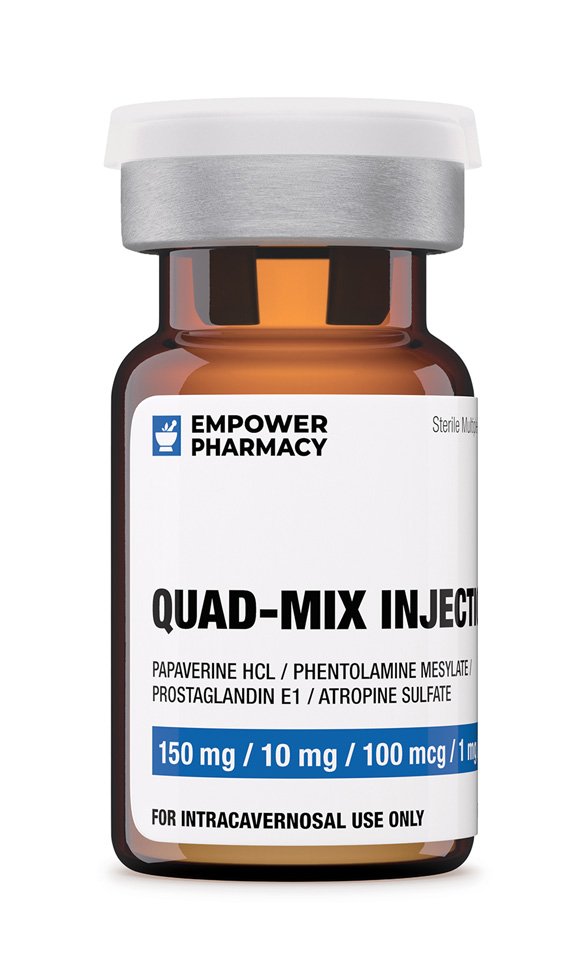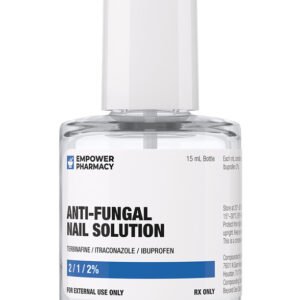QuadMix is administered as a penile self-injection, typically considered to be the most powerful class of anti-erectile dysfunction agents. While the components of QuadMix (Papaverine, Phentolamine, Prostaglandin E1, Atropine) are, on their own, indicated for a vast number of different conditions, the practice of bringing them together in concert to treat erectile dysfunction has become commonplace in sexual medicine and is now considered the go-to treatment if a patient is not responsive to conventional PDE5 inhibitors such as Viagra or Cialis. QuadMix is used in the treatment of erectile dysfunction in males. QuadMix contains four drugs from complimentary classes designed to act synergistically, mixed into a sterile injection. They are:
Papaverine HCl
A drug that causes blood vessels to expand (vasodilator); it produces an erection by allowing for increased blood flow to the penis. Papaverine interacts with adenylate cyclase resulting in increased cyclic adenosine monophosphate (cAMP) production, ultimately resulting in increased erectile capacity by relaxation of penile smooth muscle. This drug was one of the first effective therapies for erectile dysfunction administered by penile injection. Papaverine works by inhibiting phosphodiesterase nonspecifically, there are also multiple other mechanisms by which this drug acts to improve erectile capacity. The current body of medical literature has not established the predominant mechanism by which papaverine works. The multi-mechanistic manner by which this drug acts may be concentration dependent. Experimental data, performed in-vitro, displays papaverine acting to relax the penile arteries, the cavernosal sinusoids, and the penile veins. Experiments carried out in dogs display papaverine’s ability to decrease the resistance to arterial inflow while also increasing the resistance to venous outflow. Papaverine’s ability to decrease resistance to venous outflow has been replicated in clinical studies. A veno-occlusive mechanism may be responsible for the aforementioned findings.
Biweekly intracavernous administration of papaverine for erectile dysfunction.
Participants: 50 patients age 40 to 70 years old
Administration: intracavernosal injection at base of the penis
Dosage: 60 mg papaverine in 5 ml saline every 2 weeks
Results: Erection of 80% or more of normal was achieved by all but one patient, improves sexual potency
Medical treatment of impotence with papaverine and phentolamine intracavernosal injection.
Participants: 20 patients age 32 to 72 years old
Administration: intracavernosal injection
Dosage: 30 mg papaverine and phentolamine 1 mg
Results: Response with erection in 20- 30 minutes, phentolamine and papaverine produced an erection sufficient for intercourse in 18 of the 20 subjects
Treatment of impotence by intrapenile injections of papaverine and phenoxybenzamine: a double blind, controlled trial.
Participants: 39 patients age 27 to 67 years old
Administration: intracavernosal injection
Dosage: 60 mg Papaverine in 10 ml saline
Results: 35% full restoration of erectile capacity; 65% partial restoration of erectile capacity
Evaluating erectile dysfunction: oral sildenafil versus intracavernosal injection of papaverine:
Participants: 39 patients age 21 to 65 years old
Administration: intracavernosal injection
Dosage: 30 mg papaverine
Results: Papaverine improved length and circumference papaverine is effective as injection therapy for erectile dysfunction
Phentolamine Mesylate
When injected into the penis, it induces an erection by relaxing and dilating the blood vessels of the penis, as well as by elevating cardiac output.
Phentolamine is classified as an Alpha-Adrenoceptor Antagonists. Noradrenaline affects the smooth muscle tone of the penile tissues by keeping the corpora cavernosa in a contracted state. By blocking the functional noradrenaline receptors, the Alpha-Adrenoceptor, erectile response can be achieved. Phentolamine competes with endogenous norepinephrine for the Alpha1-Adrenoceptor and Alpha2-Adrenoceptor. Phentolamine has similar binding capacities to both receptors. The current literature suggests that this is the main mechanism by which phentolamine exerts its physiological effects. Phentolamine also blocks 5-HT receptors, inducing the release of histamine from mast cells. Some studies also show that NOS activation could possibly be involved in another mechanism, inducing increased vasodilation.
The Alpha-Adrenoceptor Antagonist of phentolamine is considered to be complex. The non-selective receptor blocking action interacts with adrenergic nerves in a complex fashion. Phentolamine action on adrenergic nerves has not been fully established. It is thought that there might be counteracting regulation on pre-and post-junctional nerves. It is not known how the counteracting regulation might affect the efficacy of phentolamine for the treatment of erectile dysfunction.
In animal studies, penile arterial inflow resistance was decreased. This proves in vivo that the physiological response to phentolamine acts in a manner to achieve erectile response. However, phentolamine has not displayed a significant effect on the venous outflow from penile tissues in humans. The current body of literature has not established pharmacokinetics for phentolamine.
First pass metabolism effectively reduces the efficacy in the treatment of erectile dysfunction. Therefore, this drug has to be administered by injection. The half-life of phentolamine is 30 minutes, with an effect duration of 2.5 to 4 hours. After penile injection the concentration of phentolamine in serum reaches a maximum within 20 to 30 minutes. After this amount of time has passed the drug rapidly is metabolized.
Side effects of phentolamine are rare. However, it has been reported that orthostatic hypotension, tachycardia, arrhythmias and myocardial infarction, have occurred after penile injection. The mechanism to which this set of side effects occur has not been rationally deduced through scientific study. Phentolamine is usually added in combination with papaverine or vasoactive intestinal peptide to increase erectile response.
Medical treatment of impotence with papaverine and phentolamine intracavernosal injection.
Participants: 20 patients age 32 to 72 years old
Administration: intracavernosal injection
Dosage: 30 mg papaverine and phentolamine 1 mg
Results: Response with erection in 20- 30 minutes, phentolamine and papaverine produced an erection sufficient for intercourse in 18 of the 20 subjects
Prostaglandin E1
A potent hormone-like substance that induces erection by relaxing penile blood vessels and dilating cavernosal arteries Dilation of the cavernosal arteries is accompanied by increased arterial inflow velocity and increased venous outflow resistance allowing for more blood into and less blood out of the penis.
Prostaglandin E1 is administered intracavernosally. This drug is prescribed as a second-line treatment, after oral PDE5 inhibitors have been ineffective for treatment of erectile dysfunction. Several aspects of its effects and clinical use have been reviewed previously. Currently the body of medical literature demonstrates that 40 to 70% of erectile dysfunction patients respond to treatment with prostaglandin E1. The demonstration that prostaglandin E1 with S-nitrosoglutathione in combination is more effective than prostaglandin E1 alone may shed light on the lack of efficacy in some patients.
Medications to activate alternative relaxant pathways in addition to by prostaglandin E1 may be necessary in patients who fail to respond to prostaglandin E1. Relaxation of smooth muscle is a critical component of erectile capacity. Additional agents to work in combination with prostaglandin E1 might have significant therapeutic benefits. Prostaglandin E1 with S-nitrosoglutathione or other erectile dysfunction medications, might have advantages in the treatment of male erectile dysfunction. Empower Pharmacy strives to compound medications that take advantage of multi-compound synergy. When injected into penile tissue prostaglandin E1 is readily metabolized into other erectile promoting molecules. These molecules potentiate the efficacy of prostaglandin E1. Prostaglandin E1 has been demonstrated to alter the concentrations of noradrenalin, adding a secondary mechanism of action. However, it is still believed prostaglandin E1 primarily acts directly by increasing cAMP synthesis via EP receptor interaction, increasing muscular relaxation.
Prostaglandin E1 has ubiquitous actions in controlling processes in many tissues. Known effects of prostaglandin E1 include systemic vasodilation, prevention of platelet aggregation, and ask to stimulate intestinal activity. Thus, prostaglandin E1 has very rarely been administered in a fashion to elicit a systemic response. Pharmacokinetics data is currently lacking on prostaglandin E1, the current data suggest short action duration and high rate of metabolic breakdown. After the first pass through the lungs 70% is metabolized. Because prostaglandin E1 is readily metabolized throughout the body, penile injection effects mainly penile tissues. Furthermore, this further explains the rare circulatory side effects.
Atropine Sulfate
Atropine sulfate has been used successfully in many studies in conjunction with vasoactive agents in the treatment of erectile dysfunction, when given as an intracavernosal injection.
Atropine sulfate works by inhibiting the nervous system receptors that control smooth muscle relaxation. Atropine sulfate is an anticholinergic agent that diminishes cholinergic inhibition of the adrenergic and cholinergic excitation of the nonadrenergic, noncholinergic neuroeffector systems that control neurogenic corporeal smooth muscle relaxation.
The mechanism of action also includes the release of endothelium derived relaxing factor, however this is more so involved at higher formal logical doses.






Reviews
There are no reviews yet.